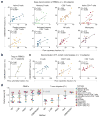Robust enumeration of cell subsets from tissue expression profiles
- PMID: 25822800
- PMCID: PMC4739640
- DOI: 10.1038/nmeth.3337
Robust enumeration of cell subsets from tissue expression profiles
Abstract
We introduce CIBERSORT, a method for characterizing cell composition of complex tissues from their gene expression profiles. When applied to enumeration of hematopoietic subsets in RNA mixtures from fresh, frozen and fixed tissues, including solid tumors, CIBERSORT outperformed other methods with respect to noise, unknown mixture content and closely related cell types. CIBERSORT should enable large-scale analysis of RNA mixtures for cellular biomarkers and therapeutic targets (http://cibersort.stanford.edu/).
Conflict of interest statement
The authors declare no competing financial interests.
Figures



Similar articles
-
Profiling Tumor Infiltrating Immune Cells with CIBERSORT.Methods Mol Biol. 2018;1711:243-259. doi: 10.1007/978-1-4939-7493-1_12. Methods Mol Biol. 2018. PMID: 29344893 Free PMC article.
-
Comparison of frozen and RNALater solid tissue storage methods for use in RNA expression microarrays.BMC Genomics. 2004 Nov 10;5:88. doi: 10.1186/1471-2164-5-88. BMC Genomics. 2004. PMID: 15537428 Free PMC article.
-
Stable phenotype of B-cell subsets following cryopreservation and thawing of normal human lymphocytes stored in a tissue biobank.Cytometry B Clin Cytom. 2015 Jan;88(1):40-9. doi: 10.1002/cyto.b.21192. Epub 2014 Oct 20. Cytometry B Clin Cytom. 2015. PMID: 25327569
-
Comparison of immunological characteristics of peripheral, splenic and tonsilar naïve B cells by differential gene expression meta-analyses.Asian Pac J Allergy Immunol. 2012 Dec;30(4):326-30. Asian Pac J Allergy Immunol. 2012. PMID: 23393914 Review.
-
Expression and Localization of Human Defensins in Palatine Tonsils.Adv Otorhinolaryngol. 2016;77:112-8. doi: 10.1159/000441888. Epub 2016 Apr 26. Adv Otorhinolaryngol. 2016. PMID: 27115892
Cited by
-
Proteogenomic analysis dissects early-onset breast cancer patients with prognostic relevance.Exp Mol Med. 2024 Nov 1. doi: 10.1038/s12276-024-01332-w. Online ahead of print. Exp Mol Med. 2024. PMID: 39482530
-
Decoding marker genes and immune landscape of unstable carotid plaques from cellular senescence.Sci Rep. 2024 Oct 31;14(1):26196. doi: 10.1038/s41598-024-78251-3. Sci Rep. 2024. PMID: 39478143 Free PMC article.
-
Single-cell landscape of innate and acquired drug resistance in acute myeloid leukemia.Nat Commun. 2024 Oct 30;15(1):9402. doi: 10.1038/s41467-024-53535-4. Nat Commun. 2024. PMID: 39477946 Free PMC article.
-
Single-cell and spatial transcriptome characterize coinhibitory cell-cell communications during histological progression of lung adenocarcinoma.Front Immunol. 2024 Oct 15;15:1430163. doi: 10.3389/fimmu.2024.1430163. eCollection 2024. Front Immunol. 2024. PMID: 39474422 Free PMC article.
-
Functional genomic analysis of the 68-1 RhCMV-Mycobacteria tuberculosis vaccine reveals an IL-15 response signature that is conserved with vector attenuation.Front Immunol. 2024 Oct 15;15:1460344. doi: 10.3389/fimmu.2024.1460344. eCollection 2024. Front Immunol. 2024. PMID: 39474415 Free PMC article.
References
-
- Hanahan D, Weinberg RA. Cell. 2011;144:646–674. - PubMed
Publication types
MeSH terms
Substances
Associated data
- Actions
Grants and funding
LinkOut - more resources
Full Text Sources
Other Literature Sources

